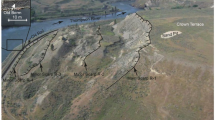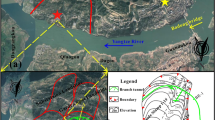Abstract
This study investigates water-induced weakening retrogressive landslides and proposes a stability evaluation method based on the two-surface progressive failure mechanism. A new test device was designed to reproduce retrogressive landslides by injecting water into the sliding zone soil from bottom to top, and the inclination angles of trailing edge fracture surfaces and horizontal displacement were measured. Then, the calculated inclination angles were taken as slice types, which were combined with the shear stress‒shear displacement constitutive model and the shear displacement model of the sliding surface to characterize the stability change caused by deformation development of slopes and define the quantitative relationship between horizontal displacement and safety factor. The model test reproduces the progressive formation process of multistage sliding masses. Each sliding mass showed two failure surfaces, a bottom sliding surface and a trailing edge fracture surface. The inclination angles of the trailing edge fracture surfaces were 66 ~ 90°. Moreover, the relative errors between the theoretical and experimental inclinations were 1.33 ~ 9.09% for the model slope. For the actual landslide, the relative errors (SM3 ~ SM7) between the theoretical and actual inclinations were 1.45 ~ 10.94%, and the relative errors of SM1 and SM2 were larger because of large deformation, so the calculation of inclination angles was not suitable for slopes with large deformation. The relative error of the total displacement was 2.33%. These tiny differences suggest that the theoretical approach is applicable. This theoretical method can infer the stability of landslide through macroscopic deformation and drilling sampling.






















Similar content being viewed by others
References
Alimohammadlou Y, Najafi A, Gokceoglu C (2014) Estimation of rainfall-induced landslides using ANN and fuzzy clustering methods: a case study in Saeen Slope, Azerbaijan province. Iran Catena 120:149–162. https://doi.org/10.1016/j.catena.2014.04.009
Amini M, Ardestani A, Khosravi MH (2017) Stability analysis of slide-toe-toppling failure. Eng Geol 228:82–96. https://doi.org/10.1016/j.enggeo.2017.07.008
Azarafza M, Akgün H, Atkinson PM, Derakhshani R (2021a) Deep learning-based landslide susceptibility mapping. Sci Rep 11(1):1–16. https://doi.org/10.1038/s41598-021-03585-1
Azarafza M, Akgün H, Ghazifard A, Asghari-Kaljahi E, Rahnamarad J, Derakhshani R (2021b) Discontinuous rock slope stability analysis by limit equilibrium approaches-a review. Int J Digi Earth 14(12):918–1941. https://doi.org/10.1080/17538947.2021.1988163
Azarafza M, Asghari-Kaljahi E, Akgün H (2017) Assessment of discontinuous rock slope stability with block theory and numerical modeling: a case study for the South Pars Gas Complex, Assalouyeh. Iran Environ Earth Sci 76(11):397. https://doi.org/10.1007/s12665-017-6711-9
Azarafza M, Zhu HH (2022) Key-block theorem application on discontinuous rock slope instabilities and rock mass description. In Belt and road webinar series on geotechnics, energy and environment. 200–208. https://doi.org/10.1007/978-981-16-9963-4
Ding Y, Dang C, Yuan GX, Wang QC (2012) Characteristics and remediation of a landslide complex triggered by the 2008 Wenchuan, China earthquake-case from Yingxiu near the earthquake epicenter. Environ Earth Sci 67:161–173. https://doi.org/10.1007/s12665-011-1489-7
Graber A, Santi P, Arestegui PM (2021) Constraining the critical groundwater conditions for initiation of large, irrigation-induced landslides, Siguas River Valley. Peru Landslides 18(12):3753–3767. https://doi.org/10.1007/s10346-021-01767-6
Guo C, Zhang Y, Li X, Ren S, Yang Z, Wu R, Jin J (2020a) Reactivation of giant Jiangdingya ancient landslide in Zhouqu County, Gansu Province, China. Landslides 17:179–190. https://doi.org/10.1007/s10346-019-01266-9
Guo J, Xu M, Zhang Q, Xiao XX, Zhang SS, He SM (2020b) Reservoir regulation for control of an ancient landslide reactivated by water level fluctuations in Heishui River. China J Earth Sci 31(6):1058–1067. https://doi.org/10.1007/s12583-020-1341-7
He C, Hu X, Tannant DD, Tan F, Zhang Y, Zhang H (2018) Response of a landslide to reservoir impoundment in model tests. Eng Geol 247:84–93. https://doi.org/10.1016/j.enggeo.2018.10.021
Huang CC (2013) Developing a new slice method for slope displacement analyses. Eng Geol 157:39–47. https://doi.org/10.1016/j.enggeo.2013.01.018
Huang D, Gu DM, Song YX, Cen DF, Zeng B (2018) Towards a complete understanding of the triggering mechanism of a large reactivated landslide in the Three Gorges Reservoir. Eng Geol 238:36–51. https://doi.org/10.1016/j.enggeo.2018.03.008
Huang D, Luo SL, Zhong Z, Gu DM, Song YX, Tomás R (2020) Analysis and modeling of the combined effects of hydrological factors on a reservoir bank slope in the Three Gorges Reservoir area, China. Eng Geol 279:105858. https://doi.org/10.1016/j.enggeo.2020.105858
Hu XL, Zhang M, Sun MJ, Huang KX, Song YJ (2015) Deformation characteristics and failure mode of the Zhujiadian landslide in the Three Gorges Reservoir, China. Bull Eng Geol Environ 74:1–12. https://doi.org/10.1007/s10064-013-0552-x
Jiang Q, Cui J, Feng XT, Jiang YJ (2014) Application of computerized tomographic scanning to the study of water-induced weakening of mudstone. Bull Eng Geol Env 73(4):1293–1301. https://doi.org/10.1007/s10064-014-0597-5
Kainthola A, Verma D, Thareja R, Singh TN (2013) A review on numerical slope stability analysis. Int J Sci Eng Technol Res (IJSETR) 2(6):1315–1320
Kennedy R, Take WA, Siemens G (2021) Geotechnical centrifuge modeling of retrogressive sensitive clay landslides. Can Geotech J 58:1452–1465. https://doi.org/10.1139/cgj-2019-0677
Kumar N, Verma AK, Sardana S, Sarkar K, Singh TN (2018) Comparative analysis of limit equilibrium and numerical methods for prediction of a landslide. Bull Eng Geol Environ 77(2):595–608. https://doi.org/10.1007/s10064-018-1247-0
Lian BQ, Peng JB, Zhan HB, Huang QB, Wang XG, Hu S (2020) Formation mechanism analysis of irrigation-induced retrogressive loess landslides. CATENA 195:104441. https://doi.org/10.1016/j.catena.2019.104441
Liao K, Wu Y, Miao F, Li L, Xue Y (2021) Effect of weakening of sliding zone soils in hydro-fluctuation belt on long-term reliability of reservoir landslides. Bull Eng Geol Env 80:3801–3815. https://doi.org/10.1007/s10064-021-02167-9
Li Q, Wang YM, Zhang KB, Yu H, Tao ZY (2020) Field investigation and numerical study of a siltstone slope instability induced by excavation and rainfall. Landslides 17(6):1485–1499. https://doi.org/10.1007/s10346-020-01396-5
Li SJ, Sun QC, Zhang ZH, Luo XQ (2018) Physical modeling and numerical analysis of slope instability subjected to reservoir impoundment of the Three Gorges. Environ Earth Sci 77:138. https://doi.org/10.1007/s12665-018-7321-x
Liu D, Hu X, Zhou C, Xu C, He C, Zhang H, Wang Q (2020) Deformation mechanisms and evolution of a pile-reinforced landslide under long-term reservoir operation. Eng Geol. https://doi.org/10.1016/j.enggeo.2020.105747
Liu B, Wang CK, Liu ZY, Xu ZH, Nie LC, Pang YH, Wang N, Feng SX (2021) Cascade surface and borehole geophysical investigation for water leakage: a case study of the Dehou reservoir, China. Eng Geol 294:1–12. https://doi.org/10.1016/j.enggeo.2021.106364
Liu F, Li J (2015) Landslide erosion associated with the Wenchuan earthquake in the Minjiang River watershed: implication for landscape evolution of the Longmen Shan, eastern Tibetan Plateau. Nat Hazards 76(3):1911–1926. https://doi.org/10.1007/s11069-014-1575-8
Xu X, Guo WZ, Liu Y, Ma J, Wang W, Zhang H, Gao H (2017b) Landslides on the Loess Plateau of China: a latest statistics together with a close look. Nat Hazards 86:1393–1403. https://doi.org/10.1007/s11069-016-2738-6
Yin YP, Huang BL, Zhang Q, Yan GQ, Dai ZW (2020) Research on recently occurred reservoir-induced Kamenziwan rockslide in Three Gorges Reservoir, China. Landslides 17 (8):1935–1949. https://doi.org/10.1007/s10346-020-01394-7
Zou Z, Lei D, Jiang G, Luo B, Chang S, Hou C (2020) Experimental study of bridge foundation reinforced with front and back rows of anti-slide piles on gravel soil slope under El Centro Waves. Appl Sci 10:3108. https://doi.org/10.3390/app10093108
Lu Y, Huang X, Liu D (2015) Force-desplacement method of slice block analysis of slope stability and its application. Rock Soil Mecha 36 (10):2780–2786. (in Chinese)
Lu Y (2015) Deformation and failure mechanism of slope in three dimensions. J Rock Mech Geotech Eng 7(2):109–119. (in Chinese)
Lv H, Ling C, Hu B, Ran J, Zheng Y, Xu Q, Tong J (2019) Characterizing groundwater flow in a translational rock slide of southwestern China. Bull Eng Geol Environ 78(3):1989–2007. https://doi.org/10.1007/s10064-017-1212-3
Nanehkaran YA, Mao Y, Azarafza M, Kockar M K, Zhu HH (2021) Fuzzy-based multiple decision method for landslide susceptibility and hazard assessment: a case study of Tabriz, Iran. Geomech Eng 24(5):407–418. https://doi.org/10.12989/gae.2021.24.5.407
Oezdemir A, Delikanli M (2009) A geotechnical investigation of the retrogressive Yaka Landslide and the debris flow threatening the town of Yaka (Isparta, SW Turkey). Nat Hazards 49(1):113–136. https://doi.org/10.1007/s11069-008-9282-y
Pan YH, Chen JP, Wu LQ, Wang W, Tan FL (2017) Evolution mechanism and rainfall warning criteria for Maijianwo Slope in Henan Province. China Geotech Geol Eng 35(1):183–194. https://doi.org/10.1007/s10706-016-0096-5
Qi X, Xu Q, Liu F (2018) Analysis of retrogressive loess flowslides in Heifangtai. China Eng Geol 236:119–128. https://doi.org/10.1016/j.enggeo.2017.08.028
Regmi RK, Jung K, Nakagawa H, Kang J (2014) Study on mechanism of retrogressive slope failure using artificial rainfall. CATENA 122:27–41. https://doi.org/10.1016/j.catena.2014.06.001
Sarma SK (1973) Stability analysis of embankments and slopes. Geotechnique 23(3):423–433
Shan Z, Zhang W, Wang D, Wang L (2021) Numerical investigations of retrogressive failure in sensitive clays: revisiting 1994 Sainte-Monique slide, Quebec. Landslides 18:1327–1336. https://doi.org/10.1007/ss10346-020-01567-4
Spencer E (1967) A method of analysis of the stability of embankments assuming parallel inter-slice forces. Geotechnique 17(1):11–26
Sun GH, Zheng H, Tang HM, Dai FC (2016) Huangtupo landslide stability under water level fluctuations of the Three Gorges reservoir. Landslides 13(5):1167–1179. https://doi.org/10.1007/s10346-015-0637-7
Sun L, Kai C, Yixuan W (2021) Model test study on retrogressive and sliding mechanism of reservoir-reactivated landslide. Journal of Harbin Institute of Technology 53(11):162–170. (in Chinese)
Sun L, Yang T, Cheng Q, Wu D (2018) Experimental study on couse of progressive formation of retrogressive landslide. J Southwest Jiaotong Univ 53(4):762–771 (in Chinese)
Take WA, Beddoe RA, Davoodi-Bilesavar R, Phillips R (2015) Effect of antecedent groundwater conditions on the triggering of static liquefaction landslides. Landslides 12(3):469–479. https://doi.org/10.1007/s10346-014-0496-7
Thiebes B, Bell R, Glade T, Jäger S, Mayer J, Anderson M, Holcombe L (2014) Integration of a limit-equilibrium model into a landslide early warning system. Landslides 11(5):859–875. https://doi.org/10.1007/s10346-013-0416-2
Wang L, Sun DA, Li L (2019) Three-dimensional stability of compound slope using limit analysis method. Can Geotech J 56(1):116–125. https://doi.org/10.1139/cgj-2017-0345
Wang Q, Wang Z, Su Y, Zhong X, Wang L, Ma H, Zhang G, Woolery EE, Liu K (2021) Characteristics and mechanism of the landslide in Yongguang village, Minxian County, China. Nat Hazards 105:1413–1438. https://doi.org/10.1007/s11069-020-04360-7
Wang Z, Ye XM, Liu YX (2018) Improved Janbu slices method considering progressive destruction in a landslide. Rock Soil Mech 39(2):675–682 (in Chinese)
White DJ, Take W, BOLTON M A, (2016) Improved image-based deformation measurement for geotechnical application. Can Geotech J 53(5):727–739. https://doi.org/10.1139/cgj-2015-0253
Wu LZ, Huang RQ, Xu Q, Zhang LM, Li HL (2015) Analysis of physical testing of rainfall-induced soil slope failures. Environ Earth Sci 73:8519–8531. https://doi.org/10.1007/s12665-014-4009-8
Wu SC, Han LQ, Cheng ZQ, Zhang XQ, Cheng HY (2019) Study on the limit equilibrium slice method considering characteristics of inter-slice normal forces distribution: the improved Spencer method. Environ Earth Sci 78:611. https://doi.org/10.1007/s12665-019-8621-5
Xu L, Dai FC, Chen J, Iqbal J, Qu YX (2014) Analysis of a progressive slope failure in the Xiangjiaba reservoir area. Southwest China Landslides 11(1):55–66. https://doi.org/10.1007/s10346-012-0373-1
Xu Q, Liu HX, Ran JX, Li WH, Sun X (2017a) Field monitoring of groundwater responses to heavy rainfalls and the early warning of the Kualiangzi landslide in Sichuan Basin, southwestern China. Landslides 13(6):1555–1570. https://doi.org/10.1007/s10346-016-0717-3
Zhang S, Xu Q, Hu ZM (2016) Effects of rainwater softening on red mudstone of deep-seated landslide, Southwest China. Eng Geol 204:1–13. https://doi.org/10.1016/j.enggeo.2016.01.013
Funding
This study was financially supported by the Science and Technology Projects of the Education Department of Jilin Province (Grant No. JJKH20210261KJ).
Author information
Authors and Affiliations
Corresponding author
Ethics declarations
Competing interest
The authors declare no competing interests.
Rights and permissions
Springer Nature or its licensor holds exclusive rights to this article under a publishing agreement with the author(s) or other rightsholder(s); author self-archiving of the accepted manuscript version of this article is solely governed by the terms of such publishing agreement and applicable law.
About this article
Cite this article
Sun, L., Li, C. & Shen, F. Two-surface progressive failure mechanism and stability quantitative evaluation of water-induced weakening retrogressive landslides: case study for clay landslides, China. Bull Eng Geol Environ 81, 382 (2022). https://doi.org/10.1007/s10064-022-02860-3
Received:
Accepted:
Published:
DOI: https://doi.org/10.1007/s10064-022-02860-3




